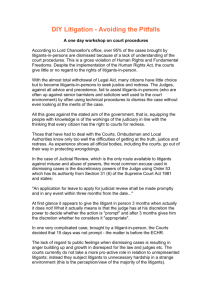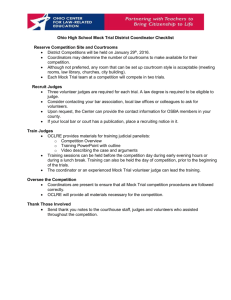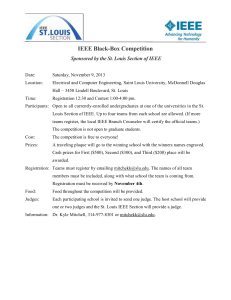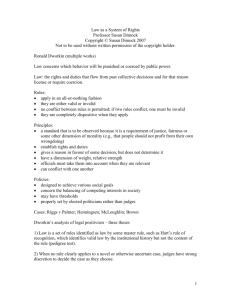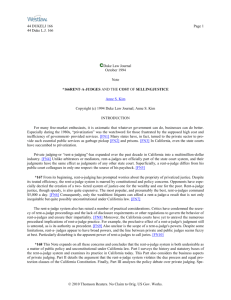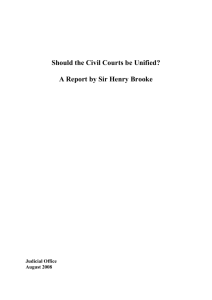US: Courts: Assignment of Cases 2008 (114)
advertisement
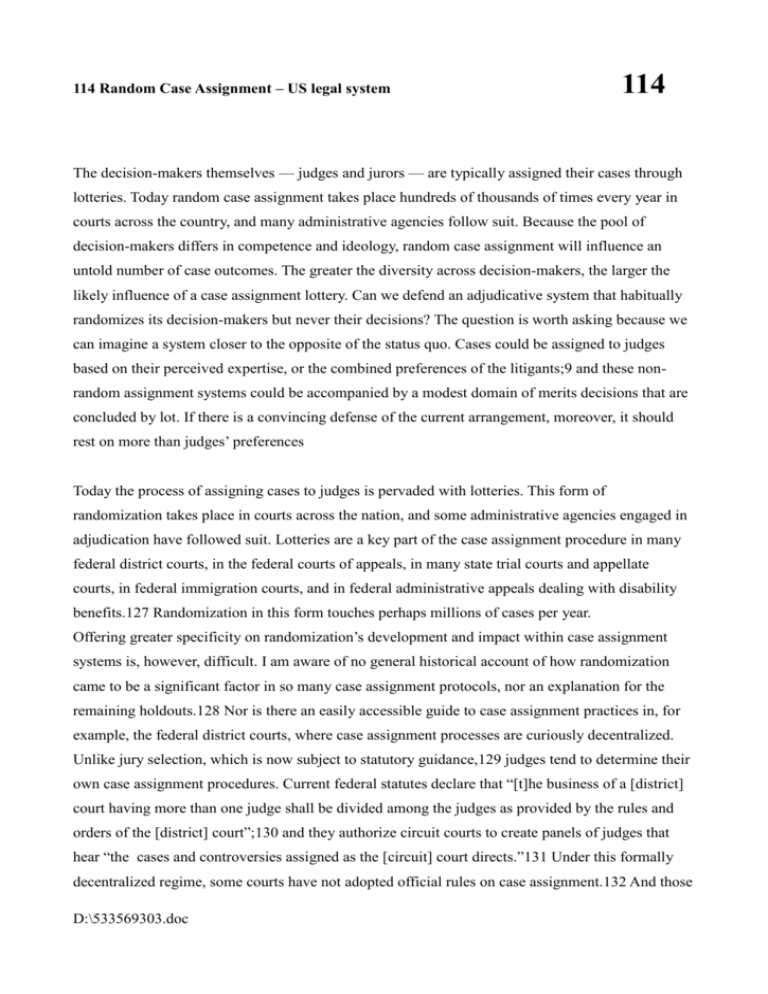
114 Random Case Assignment – US legal system 114 The decision-makers themselves — judges and jurors — are typically assigned their cases through lotteries. Today random case assignment takes place hundreds of thousands of times every year in courts across the country, and many administrative agencies follow suit. Because the pool of decision-makers differs in competence and ideology, random case assignment will influence an untold number of case outcomes. The greater the diversity across decision-makers, the larger the likely influence of a case assignment lottery. Can we defend an adjudicative system that habitually randomizes its decision-makers but never their decisions? The question is worth asking because we can imagine a system closer to the opposite of the status quo. Cases could be assigned to judges based on their perceived expertise, or the combined preferences of the litigants;9 and these nonrandom assignment systems could be accompanied by a modest domain of merits decisions that are concluded by lot. If there is a convincing defense of the current arrangement, moreover, it should rest on more than judges’ preferences Today the process of assigning cases to judges is pervaded with lotteries. This form of randomization takes place in courts across the nation, and some administrative agencies engaged in adjudication have followed suit. Lotteries are a key part of the case assignment procedure in many federal district courts, in the federal courts of appeals, in many state trial courts and appellate courts, in federal immigration courts, and in federal administrative appeals dealing with disability benefits.127 Randomization in this form touches perhaps millions of cases per year. Offering greater specificity on randomization’s development and impact within case assignment systems is, however, difficult. I am aware of no general historical account of how randomization came to be a significant factor in so many case assignment protocols, nor an explanation for the remaining holdouts.128 Nor is there an easily accessible guide to case assignment practices in, for example, the federal district courts, where case assignment processes are curiously decentralized. Unlike jury selection, which is now subject to statutory guidance,129 judges tend to determine their own case assignment procedures. Current federal statutes declare that “[t]he business of a [district] court having more than one judge shall be divided among the judges as provided by the rules and orders of the [district] court”;130 and they authorize circuit courts to create panels of judges that hear “the cases and controversies assigned as the [circuit] court directs.”131 Under this formally decentralized regime, some courts have not adopted official rules on case assignment.132 And those D:\533569303.doc that have do not necessarily explain in detail how cases and judges are matched and rematched. Somewhat similarly, the Social Security Administration appears not to have a centralized assignment rule for disability benefits appeals decided by its Administrative Law Judges. Assignment mechanics are delegated to individual hearing offices.133 Undoubtedly this information is available inside each adjudicative system and, at least partly, to local lawyers and others affiliated with these institutions. But as of today, it appears that no one source effectively aggregates this information for outsiders. While definitive statements about the particulars of its role cannot be made without additional effort, an example or two can help suggest the influence of randomization. Consider the Southern District of New York. In 2007, it had 28 authorized judgeships and logged over 17,000 case filings.134 The local rules declare that randomization is a component in case assignment: “All cases shall be randomly assigned by the clerk or his designee in public view in one of the clerk’s offices in such a manner that each active judge shall receive as nearly as possible the same number of cases . . . .”135 In addition, parties and their attorneys may ask to be present during case selection. Here the commitment to random case assignment is very public, even if the court will not entertain formal objections from litigants based on the local rule.136 An analogue from the administrative law world involves international immigration. The Office of the Chief Immigration Judge has authorized a computerized case assignment system that assigns incoming cases by rotation through lists of available immigration judges in each immigration court.137 Still, no existing case assignment system is maximally random across all decision-makers. First of all, a decision-maker might deliberately circumvent a formal commitment to randomness.138 In addition, litigants may influence case assignment. To the extent a plaintiff or prosecutor has discretion over venue, choosing a place to file is also choosing a pool of judges. And litigants may attempt to otherwise game a random assignment system.139 Other exceptions to random assignment are officially condoned. Many state court systems permit parties to exercise peremptory strikes on judges initially assigned.140 In addition, judges might recuse themselves. Staff attorneys might influence outcomes in a subset of cases regardless of the judge assigned. And “related cases” might be assigned to the same judge. In fact, the Southern District of New York rule assigns all habeas petitions and pro se civil suits filed by the same litigant to the same judge.141 Moreover, some systems incorporate the possibility of discretionary departures from random assignment.142 The Judicial Panel on Multidistrict Litigation, which is itself composed of judges selected by the Chief Justice, determines which district judge will receive transferred actions without a commitment to randomization.143 Official rules might also enable judges to trade cases. The Southern District’s local rules authorize its chief judge to reassign any case with the consent of the D:\533569303.doc judges involved.144 And random court of appeals panels are partially checked by nonrandom opinion assignment practices. More broadly, adjudicative institutions are structured in ways that delimit random assignment. These boundaries are part of the debate over specialization in adjudication.145 Cases are certainly not randomly assigned across all government adjudicators. The labor is divided among institutions, such as the immigration system and the traditional court system. And it is partitioned again within institutions, such as the various districts within the federal court system and the divisions and specialized judge assignments within certain trial courts.146 These jurisdictional boundaries define cohorts of decision-makers who will receive one stream of disputes rather than another. Even a fully randomized case assignment system within each cohort would not reach beyond those boundaries.147 Also worth noting is the norm in the United States of allowing appeals to an authority that is not randomized. Thus the decision of an administrative law judge might be appealed to the unitary head of the relevant department, and state and federal trial court judgments can be appealed to a supreme court that does not sit in panels.148 In this way, randomization is moderated. It influences case assignment on the front lines of adjudication, while the rules offer a faint hope of attracting the attention of nonrandomized decision-makers. From: Samaha, Adam M (2008) Randomization in Adjudication (unpub. At Jan 2009) D:\533569303.doc

